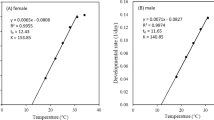Abstract
Age specific fecundity of two parasitoids,P. yaseeni andT. leucaenae, of the leucaena psyllidH. cubana, were studied under laboratory conditions. At 25 °C,P. yaseeni had a greater fecundity (R0=192.9)_thanT. leucaenae (R0=71.2);T. leucaenae however had a lower sex ratio (about 99 % females) thanP. yaseeni (about 50 % females). Innate capacity for increase (rm=0.236) ofT. leucaenae was higher thanP. yaseeni (rm=0.188). Developmental rates of the parasitoids were examined at constant and fluctuating temperatures and equations of the rate of development against temperature were calculated. At 25 °C, mean generation times were 28.0 and 18.1 days forP. yaeseeni andT. leucaenae respectively. At temperatures of 21.5, 25, and 30 °C total development times (egg to adult) were 28.5, 21.9, and 14.7 days inP. yaseeni and 19.2, 12.6, and 9.5 days inT. leucaenae respectively. The level of parasitism was low and pupal mortality was high at the lower temperature of 21.5 °C for both parasitoids. Both parasitoids showed poor survivorship at 100 % RH,P. yaseeni survived particularly well (32 days) at a temperature of 21.5 °C and 44 or 76 % RH.
P. yaseeni allocated about 58 % females to first instar psyllid nymphs but only 12 % females to second instars. About 99 % of allT. leucaenae births were females. Significantly largerT. leucaenae females emerged from fifth instar parasitized nymphs than third or fourth instars.
Résumé
La fécondité en fonction de l'âge de deux parasitoïdes du psylleHeteropsylla cubana, Psyllaephagus yaseeni etTamarixia leucaenae a été étudiée en condition de laboratoire. A 25 °C,P. yaseeni présente une fécondité plus élevée (R0=192,9) queT. leucaenae (R0=71,2);T. leucaenae montre cependant une sex ratio plus faible (environ 99 % de femelles) queP. yaseeni (environ 50 %). Le taux d'accroissement potentiel (rm=0,236) deT. leucaenae était plus élevé que celui deP. yaseeni (rm=0,188). Les vitesses de développement des parasitoïdes ont été examinées à des températures constantes et fluctuantes et les équations de la vitesse de développement en fonction de la température ont été calculées.
A 25 °C, la durée moyenne des générations était respectivement de 28,0 et 18,1 jours pourP. yaseeni etT. leucaenae. Aux températures de 21,5, 25 et 30 °C la durée totale de développement (de l'œuf à l'adulte) était de 28,5, 21,9 et 14,7 jours chezP. yaseeni et 19,2, 12,6 et 9,5 jours chezT. leucaenae. Le taux de parasitisme était faible et la mortalité nymphale était élevée à la température la plus basse, 21,5 °C, pour les deux parasitoïdes. Tous deux présentaient une survie faible à 100 % de HR;P. yaseeni survivait particulièrement bien à une température de 21 °C et à 44 ou 76% d'HR.
P. yaseeni attribuait environ 58 % de femelles aux larves de premier stade de développement mais seulement 12 % aux larves de second stade. Environ 99 % de toutes les éclosions deT. leucaenae était constituée de femelles. La taille des femelles issues des larves de 5e stade étaient significativement supérieure à la taille de celles qui émergeaient des larves de 3e ou 4e stade.
Similar content being viewed by others
References
Van Alphen, J. J. M. &Thunnissen, I. — 1983. Host selection and sex allocation byPachycrepoideus vindemiae Rondani (Pteromalidae) as a facultative hyperparasitoid ofAsobara tabida Nees (Braconidae): Alysiinae) andLeptopilina heteroma (Cynipoidea: Eucolidae). —Neth. J. Zool., 33, 497–514.
Askew, R. R. &Shaw, M. R. — 1986. Parasitoid communities their size, structure and development. InInsect Parasitoids, eds.Waage, J. F. &Greathead, D. 13th Symposium of the Royal Entomological Society of London. —Academic Pres, London.
Birch, L. C. — 1948. The intrinsic rate of natural increase of an insect population. —J. Anim. Ecol., 17, 15–26.
Charnov, E. L. — 1982. The theory of sex allocation. —Princeton University Press.
Deevey, E. S. Jr. — 1947. Life tables for natural populations of animals. —Quart. Rev. Biol., 22, 283–314.
Flanders, S. E. — 1950. Regulation of ovulation and egg disposal in the parasitic Hymenoptera. —Can. Entomol., 35, 134–140.
Groot, W. — 1990. Report of research on the leucaena pysllidH. cubana (Crawford) and its parastoidsP. yaseeni (Howard) andT. leucaenae Boucek. — Unpublished report, CAB International Institute of Biological Control, Trinidad.
McClay, A. S. — 1989. Distribution of Leucaena psyllid and its natural enemies in Mexico Implications for biological control. InLeucaena psyllid problems and management. — Proceedings of an International Workshop held in Bogor, Indonesia, January 16–21.
Murai, K. T. — 1986. Host range study of the psyllid parasitoid,Psyllaephagus sp. nr.rotundiformis (Howard). —Report of the Hawaii Department of Agriculture, Honolulu, Hawaii, 6 p.
Nakahara, L. &Funasakai, G. Y. — 1986. Natural enemies of the leucaena psyllid,Heteropsylla cubana Crawford (Homoptera: Psyllidae). —Leucaena Research Report, 7, 9–12.
Nakahara, L., Nagamine, W., Matayoshi, S. &Kumashiro, B. — 1987. Biological control programme on the leucaena psyllid,H. cubana Crawford (Homoptera: Psyllidae) in Hawaii. —Leucaena Research Report, 7, 39–44.
Southwood, T. R. E. — 1978.Ecological Methods.Methuen, London.
Waage, J. K. — 1986. Family planning in parasitoids: adaptive patterns of progeny and sex allocation. InInsect Parasitoids. 13th Symposium of the Royal Entomological Society of London. —Academic Press, London.
Waage, J. K. — 1989. Exploration for biological control agents of Leucaena psyllid in Tropical America. InLeucaena psyllid problems and management. — Proceedings of an International Workshop held in Bogor, Indonesia, January 16–21.
Winston, P. W. &Bates, H. B. — 1960. Saturated solutions for the control of humidity in biological research. —Ecology, 41, 232–237.
Author information
Authors and Affiliations
Rights and permissions
About this article
Cite this article
Patil, N.G., Baker, P.S. & Pollard, G.V. Life histories ofPsyllaephagus yaseeni (Hym., Encyrtidae) andTamarixia leucaenae (Hym., Eulophidae), parasitoids of the leucaena psyllidHeteropsylla cubana . Entomophaga 38, 565–577 (1993). https://doi.org/10.1007/BF02373091
Received:
Accepted:
Issue Date:
DOI: https://doi.org/10.1007/BF02373091




